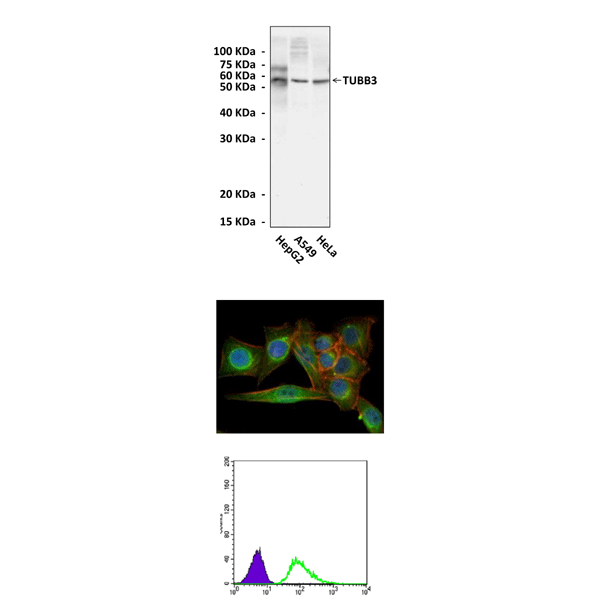Anti-TUBB3: Mouseβ-Tubulin Isotype III Antibody
Mouse beta-Tubulin Isotype III Antibody: Mouse -beta-Tubulin Isotype III Antibody
Size: 100 ul
Price: $413.00
Description
BACKGROUND Beta-Tubulin, together with alpha-tubulin, participates in the formation of microtubules, the integrity of which is essential for the segregation of chromosomes during cell division, maintenance of cell shape, and intracellular trafficking of macromolecules and organelles. Vertebrate alpha- and beta-tubulins are each encoded by a 9- to 8-member multigene family, respectively, that produces highly homologous and conserved gene products in which the sequences are highly divergent only in their last 10 to 15 amino acids. These carboxyl-terminal sequences have been used to assign beta-tubulin gene products to at least seven distinct classes. Each of these classes defines a beta-tubulin isotype that differs significantly from other isotypes within the same organism but differs very little from the same isotype in other vertebrate species. Microtubule behavior varies according to isotype composition, suggesting that each isotype may have properties necessary for specific cellular functions. The carboxyl-terminal regions of both alpha- and beta-tubulin undergo numerous posttranslational modifications capable to modulate the function of the microtubule, such as glutamylation, glycosylation, tyrosination, acetylation, and acylation. Tubulin can also be phosphorylated by several kinases, and such changes affect the overall dynamic properties of cellular microtubules during interphase as well as mitosis. It has been suggested that modification of certain cysteine residues of tubulin might regulate the dimer/microtubule equilibrium and that the thioredoxin system might, in turn, regulate this equilibrium.1 Class I and II are the most abundant beta-tubulin isotypes and are constitutively expressed. Beta-tubulin isotype III (TUBB3) is distinct because purified microtubules enriched in TUBB3 are considerably more dynamic than those composed from other beta-tubulin isotypes, and because its expression is primarily limited to neurons. TUBB3 expression is greatest during periods of axon guidance and maturation; levels decrease in the adult central nervous system (CNS) but remain high in the peripheral nervous system (PNS). Thus, the unique dynamic properties and spatio-temporal expression pattern of TUBB3 suggest that it could have a specific function for nervous system development and axon maintenance. The microtubule network is crucial for the developing nervous system and mutations in tubulin-encoding genes disrupt neuronal migration. It was shown that mutations in the neuronal TUBB3 gene have a striking impact on microtubule dynamics resulting in a diverse set of disease symptoms.2 Although class III beta-tubulin (TUBB3) has been reported previously to as an isotype specific for neuronal tissues and testis, TUBB3 expression has also been observed in other tissues and particularly in the mitochondrial membrane. It was reported that compartmentalization into mitochondrion and cytoskeleton is associated to a different pathway of posttranslational changes on TUBB3.3 Moreover, TUBB3 appears inserted in a functional network of factors involved in the adaptation to oxidative stress and glucose deprivation, thereby suggesting that it is a part of a survival pathway that directly contributes to the acquisition of the drug-resistant phenotype. Several reports indicate that an increase in the relative abundance of TUBB3 isoform destabilizes the microtubules and correlates with drug resistance. Furthermore, the glycosylation and phosphorylation status of TUBB3 correlates with the paclitaxel-resistant phenotype. TUBB3 has assumed an important role as a clinical marker of drug resistance in ovary, lung, stomach, pancreas, and breast cancer patients.4 In fact, it seems that TUBB3 represents an endogenous element of an inherent drug-resistance program built into cells to counteract the activity of microtubule-interacting drugs.
REFERENCES
1. Cleveland, D.W. et al: Ann. Rev. Biochem. 54:331-65, 1985 2. Tischfield, M.A. et al: Cell 140:74-87, 2010 3. Cicchillitti, L. et al: Mol. Cancer ther. 7:2070-9, 2008 4. Ferlini, C. et al: Curr. Cancer Drug Target. 7:704-12, 2007
Products are for research use only. They are not intended for human, animal, or diagnostic applications.
Details
| Cat.No.: | CP10240 |
| Antigen: | Purified recombinant human TUBB3 fragments expressed in E. coli. |
| Isotype: | Mouse IgG1 |
| Species & predicted species cross- reactivity ( ): | Human |
| Applications & Suggested starting dilutions:* | WB 1:1000 IP n/d IHC n/d ICC 1:100 – 1:200 FACS 1:100 – 1:200 |
| Predicted Molecular Weight of protein: | 53 kDa |
| Specificity/Sensitivity: | Detects endogenous TUBB3 proteins without cross-reactivity with other family members. |
| Storage: | Store at -20°C, 4°C for frequent use. Avoid repeated freeze-thaw cycles. |
*Optimal working dilutions must be determined by end user.
